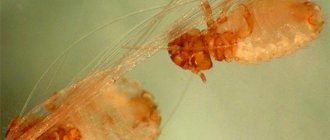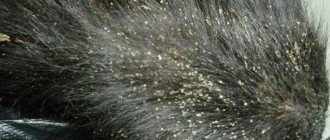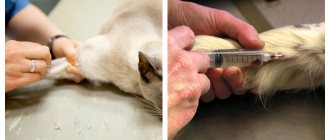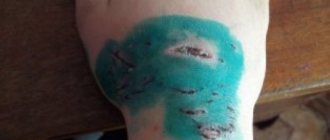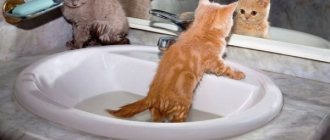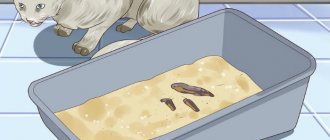Trichodectosis is the general name of a parasitic disease that can be caused in birds and animals by various arthropods belonging to the orders of lice and feather eaters, lice eaters and lice eaters (wool eaters). Including cats, they are susceptible to the disease caused by lice eaters.
This article was written within the framework of the information cluster of Acarosa for cats. Article continues after advertisement
Who are lice eaters in cats?
The scientific name of lice eaters that can parasitize the placental group of mammals, which includes the cat family, is Trichodectidae. Lice-eaters and lice-eaters, as well as wool-eaters (wool-eaters) are variants of the Russian-language name for parasites that live and parasitize in the fur of animals. These insects feed on skin cells, fur and body fluids of the host, secreted onto the surface of the skin naturally, as well as through scratching and injury. In English-speaking countries, the word "lice" is used - louse: it is applied to the same parasites that Russian-speaking veterinarians know as lice-eaters. With one caveat, that in their terminology Western veterinarians divide lice into biting/chewing and sucking lice.
Felicola subrostratus is an arthropod parasite that parasitizes exclusively on cats and causes the disease trichodectosis; in Russian-language literature it is called “the lice eater”, and in foreign publications it appears as “cat chewing louse”.
The causative agent of trichodectosis in cats has nothing to do with mites, as some owners sometimes mistakenly believe, calling the parasite a “hair-eater mite” and confusing trichodectosis with manifestations of sarcoptic mange (mange). Both pathogens are arthropod parasites, but that's where their similarities end. Itching mites belong to the class of arachnids and are infectious to humans, and the Felicola subrostratus species is an insect that cannot live on humans. They look, live, reproduce and feed differently.
The development cycle of the lice eater, which causes trichodectosis in cats, lasts 4-5 weeks. Every day, throughout her 30-day life, the female lays several eggs (they are also called nits). She attaches them to the base of the animal's fur. After 10-12 days, larvae (nymphs) hatch from the eggs of the lice eater, which in 2-3 weeks turn into an imago (mature individual). Understanding the life cycle is important for prescribing the correct treatment for the disease.
The cat lice eater is a specific parasite that spends its entire short life on the same host, i.e. on a sick cat. It is not capable of existing on other mammals, including humans. After leaving the cat's body, the parasite can survive for 5-7 days and then dies.
The main harm caused by cat lice eaters is economic, aesthetic and moral. Trichodectosis spoils the appearance and emotional state of a sick animal. The owner also experiences psychological discomfort when a pet is infected with a lice eater, and he is also forced to spend significant money and time on treating the animal.
The name of the disease “trichodectosis”, caused by lice-eaters of the suborder Trichodectidae, is used by veterinarians of the modern school. Previously, until 2001, veterinary dermatology specialists could call this same disease “mallophagosis” or “pediculosis.” The reason for this is the changed scientific classification since 2001, according to which two separate orders - lice and lice - were equated to four suborders of the family Phthiraptera, which is translated from Greek as “wingless louse”.
Are lice eaters dangerous for humans?
- The animal's temperature is much higher than that of humans , so lice eaters cannot parasitize humans. Insects love warmth.
- The only danger is an accidental parasite bite. Since lice eaters are carriers of infections, humans, like animals, are in danger.
- Worm eggs can be transferred by insects to the human body.
When a dog bites, larvae can enter the bloodstream and develop under the skin. At this moment, itching will be felt, so you cannot do without a specialist.
Ways of infection with trichodectosis
Lice eaters are quite rare parasites in cats. Young, old and weakened individuals are more susceptible to trichodectosis. Without direct contact with a carrier of parasites, it is almost impossible for a healthy, well-groomed animal to become infected.
Lice eaters in most animal species have the ability to parasitize only certain warm-blooded animals. Thus, cat lice parasites can live only on cats, canine parasites on dogs, and human parasites on humans.
Article continues after advertisement
Lice eaters in cats have a structure that does not allow them to move from one owner to another. These ectoparasites spend their entire life cycle on one host - a cat, unless a forced “relocation” occurs, for example, through direct contact of a sick animal with lice on its fur with a healthy individual or by using care products and equipment from an infected cat on a healthy one.
Transmission routes and risk factors
The appearance of lice-eaters is possible at any age, regardless of gender or seasons. Parasites are transmitted by contact when communicating with a carrier. This could be another cat, a dog, large pets and livestock, as well as rodents that the cat hunts. If a mother cat is infected with lice eaters, then they move onto the kittens.
In rare cases, it is possible that eggs or larvae of lice beetles may be transmitted on poorly sterilized tools used by the groomer.
Meeting parasites does not always lead to infection. If the cat receives good care and a balanced diet, then its immunity will allow it to cope with infection.
Animals whose immune systems, for one reason or another, do not function well enough, are at greater risk of contracting parasitic insects. This applies to small kittens and very elderly cats. Immunity may decrease after an infectious disease or surgery.
There are insufficient protective forces in animals that have severe chronic pathologies.
Trichodectosis in cats: symptoms
Depending on the severity of the disease, symptoms may vary slightly in intensity. But owners should know the main signs of lice in cats:
- restless behavior associated with itching and intense scratching of the affected areas;
- the fur of sick cats is dull, broken and tousled;
- whitish balls (nits) are present at the base of the hair shafts;
- adult parasites measuring 1-1.5 mm in size are noticeable on the skin and in the down;
- if the intensity of invasion (infection) is small, then nits and parasites may be invisible to the naked eye, but scabs, abrasions from scratching, flakes of skin epithelium resembling dandruff, as well as bald patches will be visible;
- the presence of lice eaters in a cat can even cause necrotic symptoms on the skin due to deep injuries and suppuration after intense scratching;
- in severe cases, the lice eater in a cat can cause anemia and all the troubles associated with it.
Understanding how hairworm manifests itself in a cat allows you to take timely measures in case of suspected infection and successfully provide timely assistance to a sick animal. At the first signs of lice in cats, you should immediately contact a veterinarian for dermatological examinations and an accurate diagnosis. This is especially true if there is more than one cat in the house or if there is a risk of infection of other people's cats, for example, at exhibitions.
Signs of presence
How to determine by external signs whether your kitten is infected with lice or not?
Firstly , he will strongly scratch the bite area, the itching is especially severe at night, the cat practically does not sleep because of this. The pet will bite parasites and actively lick the fur.
Secondly , the cat stops listening to the owner, stops playing, becomes irritable and lethargic.
Thirdly , in places where a large number of insects accumulate, baldness appears, as well as dry white elements similar to dandruff.
Murkoshi specialists advise using one method to detect the presence of lice eaters. Bring a light bulb to your cat and in a few minutes you will be able to see parasites gathering in the warmth at the ends of the hairs. No other insects will do this. It should be noted that bacteria and infection can enter the combed areas and, as a result, inflammation will begin. Therefore, it is necessary to start treatment as quickly as possible.
Diagnostics
The best option to diagnose trichodectosis is to contact a competent veterinarian who has the opportunity to professionally examine, provide assistance and advise. A veterinarian, based on anamnesis (the history of the onset of the disease told by the owner), clinical examination, microscopic examination and differential diagnosis (excluding diseases with similar symptoms), will be able to accurately determine whether the cat is infected with Felicola (feline beetle).
Similar diseases that should be excluded if a diagnosis of trichodectosis is suspected are:
- flea dermatitis;
- cheyletiosis;
- atopic dermatitis;
- food allergies;
- thrombidiasis.
For various reasons, it may not be possible to conduct a diagnosis from a veterinarian. How, then, can you determine whether a cat has lice eaters? In this case, those owners who have access to a microscope will have an advantage. They can use the tape test imprint method: the adhesive side of the tape is applied to suspicious bald spots on the cat, pressed, then torn off and transferred to clean, grease-free glass, to which it is glued. The imprint obtained in this way is examined under a microscope in search of nits and adult ectoparasites. The cat Felicola subrostratus looks like this.
Lice eater under a microscope
If there is no tape, you can scrape the skin using a disinfected sharp blade: you need to scratch the skin with it until the ichor is gone. Spread the released liquid, skin cells and some hair from the affected areas in a thin layer on a glass slide. Place 1-2 drops of saline solution (from a regular pharmacy) or clean (preferably distilled) water on top of the smear. Cover such a smear with a cover glass and examine it at low magnification in a conventional biological microscope.
If you don’t have access to a microscope, then you can only rely on your vision and logic. It is important to think: what life circumstances preceded the manifestation of symptoms and could cat lice eaters attack the animal as a result of these circumstances?
Symptoms of canine lice infestation
The clinical picture of trichodectosis resembles the symptoms of infection with fleas, lice and ticks:
- Severe itching of the skin. The animal tries to relieve the itching by scratching itself.
- Changes in coat structure. Dog hair loses its shine and sticks together. The dog looks disheveled.
- Hair loss. Complete baldness is possible on the tail, inner thighs and muzzle.
- The skin in areas of bald patches becomes rough, red, and crusty.
- On the dog's fur you can notice small white grains that move.
- Dermatitis in areas scratched by the dog.
- Extreme thirst and loss of appetite.
- Behavioral changes: sleep disturbances, aggression, anxiety, loss of attention.
- Decreased immunity.
- Delayed growth and development (in puppies).
Why is trichodectosis dangerous for a dog?
Causes functional disorders in the animal's body.
- Reduces immunity.
- Weakens the skin barrier function.
- Causes complete baldness of the dog.
- The causative agents of the disease are carriers of leptospira, fungi and helminth eggs.
Due to the fact that the clinical symptoms of many parasitic diseases are similar, it is important to correctly diagnose.
How to remove hairworms from a cat: treatment of trichodectosis
The fight against lice eaters and hair eaters is quite simple. These insects are easily killed by all kinds of cat products used to control fleas and ticks. In this case, the owner has the opportunity to choose any convenient form of the drug: sprays, drops, shampoos, collars and powders.
The most effective and safe remedy for lice for cats can have any commercial name, but the main thing is that the active ingredients in it are the following:
Article continues after advertisement
- selamectin;
- imidacloprid;
- fipronil.
Information about the active substance can be found at the beginning of the instructions for the product.
Preparations for hairworms in cats, the active ingredients of which are pyrethrins and pyrethroids or carbamates, should be used only as a last resort and with great caution, because Cats' bodies can suffer greatly from poisoning with these substances. In this regard, such drugs and collars were prohibited for sale in the United States. In our country they are still allowed, but some cats die as a result of the use of such poisons.
Any treatment must be comprehensive. Depending on the clinical picture, the treatment regimen should be selected individually. Considering that the cat's hair eater is located in the cat's fur, it is necessary to conduct a visual assessment of it and, if necessary, completely remove the hair in the affected areas.
If the infection stage is initial, you can resort to the folk remedies described below. But if the cat’s lice-eaters do not go away and treatment does not give the desired effect, then you should immediately turn to traditional therapy.
In more serious cases you may need:
- antibiotic therapy;
- hepatoprotectors;
- vitamin and restorative preparations;
- anthelmintics;
- antifungal agents;
- antitoxic agents with infusions (droppers).
How to prevent your pet from becoming infected?
To prevent your pet from becoming infected with these ectoparasites, you must:
- protect your dog and cat from contact with stray animals while walking;
- After each walk, inspect your four-legged friend to identify lice eaters;
- use preventive means of protection (sprays, collars, drops) to prevent attacks by parasites;
- provide your pet with a balanced diet;
- Regularly give your pet vitamin complexes to strengthen the immune system;
- promptly treat identified diseases;
- Conduct preventive veterinary examinations at least once a year;
- check if the pregnant pet has ectoparasites;
- when a new animal appears in the house, make sure that it does not have trichodectosis;
- regularly wash and disinfect cat and dog beds and toys;
- prevent your pet from coming into contact with outdoor shoes and door mats;
- isolate an infected cat or dog from animals living with them in the same area;
- after treatment, keep the pet who has recovered from trichodectosis in quarantine for several weeks;
- carry out vaccination and deworming in a timely manner.
Preparations for lice in cats
Modern veterinary pharmacies offer a huge number of medications for lice in cats with a wide range of prices. All drugs used to kill lice eaters act on their nervous system and cause the death of parasites. But few products destroy the eggs and larvae of Felicola, so after a while, when they turn into adults, repeated treatments are carried out.
It is natural that all drugs used to kill lice eaters have some toxic effect on a warm-blooded animal, in our case, a cat. Therefore, it is of great importance which remedy for lice is prescribed to a particular patient to achieve maximum therapeutic effect with minimal harm to the victim.
Here are some drugs (commercial names) prescribed for lice in modern veterinary medicine.
Bravecto (drops on the withers)
The active ingredient is fluralaner from the insectoacaricidal group of isoxazoline.
It must be used with caution, observing the dosage, because... There are known cases of side effects in mammals. BUY IN UKRAINE
Article continues after advertisement
Advantage (drops on the withers)
This drug for hairworms in cats is often recommended in pet stores and veterinary pharmacies.
Active ingredient: pesticide imidacloprid, also sold under the commercial names “Confidor”, “Kopfidor”, “Admir”, “Gaucho”. Belongs to the class of neonicotinoids. BUY IN UKRAINE
BUY ON AMAZON
Stronghold
“Stronghold” (drops on the withers) is one of the most successful and recommended remedies for lice in the USA and Europe.
It's all about the active ingredient selamectin, which is well tolerated by cats. BUY IN UKRAINE
Leopard (drops on the withers)
A popular remedy for lice eaters and other arthropod ectoparasites.
Contains 3 active ingredients at once: fipronil, diflubenzuron, dicarboximide. Its popularity is mainly due to its relatively low price. Article continues after advertisement
BUY IN UKRAINE
Manufacturers also offer all kinds of forms of antiparasitic drugs: sprays, collars, injections, drops against lice in cats. What's better? What to choose? In fact, there is little difference in what form the drug will be used. To begin its work, any insectoacaricide needs to reach the parasite with food. And their food is blood and lymph. This means that any remedy for fleas, lice, lice and ticks for cats is partially absorbed and circulates in the animal’s blood. From here it becomes clear why there are cases of toxic poisoning of cats themselves after the use of drugs, and not just the death of parasitic insects.
When using any medicine for lice, it is important:
- observe the dosage, taking into account the weight of the animal;
- for cats, use only products for cats, take into account your animal’s individual tolerance to one or another active substance;
- give preference to drugs banned in other countries due to the content of tetrachlorvinphos (an officially recognized carcinogen), only in cases where the expected benefit to the animal is higher than the harm from possible side effects: keep in mind that even such reputable companies as Hartz, Beaphar , Zodiac and others produce similar products, therefore, when choosing a drug, read the composition, and do not blindly trust the famous manufacturer;
- use medications only in cases where the pet belongs to acceptable groups of animals: by age, species, pregnancy and lactation.
And once again we emphasize that any synthetic parasite repellents are potentially dangerous for pets. After using the drug, save the packaging. After using drops, sprays and collars, as well as administering injections, be sure to monitor the animal’s well-being. In case of any deterioration, you should immediately contact your veterinarian for antitoxic therapy.
Description of the cat lice eater
The cat lice eater looks like a flat beige bug several centimeters long (usually 1-2 cm).
The structural features of the cat lice eater are as follows:
- wings are missing;
- the belly is elongated, oval-shaped, covered with bristles;
- the breast is underdeveloped, divided into three segments;
- three pairs of legs are equipped with hooks that dig into the cat’s skin;
- the head is disproportionately large, has short mustaches;
- mouth is large;
- triangular eyes are underdeveloped;
- color varies from whitish to light red.
The exoparasite feeds on the animal’s blood, dead epidermis, and particles of fur.
The female lays 100-120 eggs on the fur, attaching them to the hairs with sticky mucus.
The larvae go through 3 stages of maturation in 28 days, turning into adults. Rapid reproduction occurs in autumn and winter. Lice eaters, unlike lice and fleas, cannot survive without the host's body.
Folk remedies for lice
When there is no desire or opportunity to use synthetic products to treat cats against lice at home, and the infestation is small or absent (that is, we are talking about prevention), you can use folk remedies.
Option 1
Bathe the cat in a decoction of herbs: wormwood, medicinal chamomile and string. To prepare a decoction, the herbs must be taken in equal parts. The color of the finished decoction for bathing the animal should be close to the color of pale tea.
Option 2
It is quite acceptable to bathe a cat or kitten in tar shampoo for animals or people. But tar soap or shampoo does not destroy the lice eater. Birch tar helps weaken adults and has no effect on larvae and eggs. In addition, tar dries out the skin and coat, so you need to add burdock oil to your soap or shampoo. The soaped animal should be wrapped in film up to its neck or placed in a bag, leaving its head exposed to the air. Wrap a towel on top and hold the wrapped cat in your arms for 20-30 minutes to enhance the effect of the tar. You can't let him lick his lips. Then rinse thoroughly and comb out the lice with a very fine comb or cut the hair as short as possible. The procedure should be repeated once every two days at least 5 times.
Option 3
Get a comb with fine teeth, which is convenient for combing out parasites. Trim your cat's fur as short as possible whenever possible. Good lighting and vision, perseverance and patience will help mechanically remove parasites from the surface of the skin. To make the work easier, you can wash your cat with tar shampoo or soap before doing this. Then the lice-eaters will weaken and it will be easier to eliminate them.
You can combine all three options. Other means can also be used. The main thing is that the owner understands the difference between treatment with synthetic drugs and natural ones. In the first case, the parasites are quickly and reliably destroyed, but this method can be toxic for the cat itself. In the second case, folk remedies will gradually alleviate the situation, slowly and gradually improving the cat’s health, but you should be patient and systematically, without interruptions, carry out procedure after procedure.
Preventive measures
To avoid infecting a cat with a lice eater, the following preventive measures must be observed:
- every week inspect the animal’s fur and skin for the presence of parasites;
- use an insecticidal collar when walking;
- do not allow the cat to communicate with stray cats;
- feed with balanced food;
- Wash the tray in a timely manner;
- monitor the cleanliness of beds, toys, rugs used by the pet;
- deworm your cat quarterly;
- bathe your cat regularly using special anti-parasitic shampoos;
- When purchasing a second pet, carefully examine its fur for the presence of lice;
- Visit the veterinarian regularly and get vaccinations to prevent skin diseases.
Proper care and the owner's attentive attention to detail are the key to healthy skin and fur of a cat. If the problem is noticed in time, it will allow you to get rid of parasites as soon as possible and prevent the pet’s condition from worsening.
Treatment of trichodectosis in kittens
Kittens are at risk of becoming infected with lice because of their not yet fully formed immunity. There are three easiest ways for a kitten to get sick:
- receive parasites from the mother;
- upon contact with sick fellow tribesmen;
- from the use of ammunition and care items that have been in contact with a sick animal.
Treatment for lice in kittens is absolutely identical to how adults are treated. With the exception of one important nuance: only those drugs are used that are acceptable for use on kittens. The permissible age is always indicated in the instructions.
In addition, it is strictly forbidden to use aggressive folk remedies against ectoparasites on kittens:
- kerosene;
- table vinegar;
- cosmetic hairspray;
- vodka and other alcohols;
- combine tar-containing shampoos and soaps with dust and laundry soap.
Can it be treated at home?
If the lice-eater infestation has occurred recently and the damage is minor, you can try to treat the animal at home. To do this, you should purchase drugs against ectoparasites (fleas, ticks, lice):
- pet shampoos (“Demos-Lux”, “Flea&Tick Cat Shampoo”, “Bolfo”, “Shampoo B”, “Rolf Club”, “Mr. Kiss”, “Bars”, “Clandestine”, etc.);
- drops (“Bars”, “Clandestine”, “Biafar”, “Frontline”, “Barrier”, “Hartz”, “Advantage”);
- aerosols and sprays (“Bolfo”, “Acaromectin”, “Flea & Tick – 14 Residial Spray”, “Delix-spray”, “Serco”, “Frontline”, “KiSka”).
These medications should be used with extreme caution if lice eaters are found in a kitten. For small animals with weak immunity, you should use a lower dosage, which your veterinarian will help you choose.
Folk remedies used by animal lovers at home are not as effective as specialized drugs. However, they may well be used in the early stages of infection. For example, an animal can be bathed in a strong decoction of chamomile, string or wormwood.
Consequences of the disease
In general, the prognosis for cats infected with trichodectosis is positive. But it all depends on age, the body’s immune response, the degree of invasion and the measures used for treatment. Trichodectosis in a cat can be easily treated under the guidance of a competent veterinarian, and risks and side effects are minimized. Therefore, if possible, be sure to consult a veterinarian rather than self-medicate.
Advanced cases of lice-eater infection in weakened cats can even be fatal. Thoughtless use of anti-ectoparasite remedies can also be disastrous for the cat. According to foreign studies, any synthetic insectoacaricides are potentially dangerous for warm-blooded animals, but to varying degrees. Some cause toxic poisoning and even death without emergency treatment. There are drugs that cause cancer and other related disorders in the body. Over time, such drugs are discontinued or banned for use on pets.
Symptoms of the lesion
The activity of lice eaters leads to the following pathological symptoms:
- Itching: the arthropod gnaws the skin, inflammation occurs, the cat scratches the itchy areas, and ichor leaks out. It dries out and crusts form. Secondary microflora joins in and the itching intensifies.
- A rash appears and pustules form. The saliva of parasites, when repeatedly penetrating skin defects, causes sensitization and an allergic reaction.
- Hair loss. Lice eaters can destroy a fur coat over a large area.
- Ulcers on the skin.
- Mats in long-haired cats.
- The skin becomes inflamed, rough, swollen, and rough.
- Segments of cucumber tapeworm are found in feces.
- Against the background of a decline in immunity, subcutaneous mites - demodex - develop; notoedrus; otodectes.
Prevention
The fight against lice eaters comes down to routine preventive measures for every domestic cat. Proper prevention includes a healthy diet, hygiene procedures, regular health monitoring and the use of the most gentle preventive agents against ectoparasites with strict adherence to all recommendations from the instructions of the drugs.
It is important for every owner of a domestic cat to understand that any medications for fleas, lice, ticks, lice eaters, and hair eaters are not a toy. You cannot, in the hope of saving a cat from lice eaters, douse and weigh it down with everything that the pet market offers. For example, some people like to put a collar on and apply drops to the withers, thus giving the animal a double dose of insectoacaricides. Everything must be thought out and balanced. Prevention should be done in moderation. What is excessive is also bad.
Caring for a sick animal
A cat infected with trichodectosis does not require special care. There is also no need for nutritional correction. After the first use of medications, the pet’s well-being, as a rule, improves. To speed up the animal’s recovery, after identifying lice eaters, you must:
- carry out wet cleaning of the home by treating the surfaces with which the infected animal has come into contact with a napkin moistened with 2% Neostomozan, Ecocide or Ectomin;
- vacuum and steam toys, bed, scratching post, pet play structure;
- treat wounds with an antiseptic, for example Chlorhexidine, best done with sterile gauze;
- After finishing treatment, give the cat an anthelmintic.
If a cat is diagnosed with trichodectosis, it must be isolated from other pets. This measure will prevent them from becoming infected.
How to treat a room against lice?
Despite the fact that Felicola (the cat hair eater) can exist without food, that is, in the external environment, for up to 7 days, and then it dies, any owner wants to get rid of it as soon as possible. Naturally, if a sick cat lives in a residential area, some individuals of lice or lice eaters may be found in the apartment.
To destroy insects indoors or on care facilities for sick animals, basic treatment against lice by spraying insectoacaricides will help. The most accessible means for these purposes are preparations with the active ingredient deltamethrin (commercial name “Butox”, etc.) or tetramethrin and transmix (“Neostomazan” and analogues). Along with them, you can use other insect repellents.
The contents of the ampoule with the drug must be diluted in water in the proportions specified in the instructions. Using personal protective equipment (gloves, goggles and a respirator), spray the entire room. Due to the fact that the lice eater cannot fly or jump, it is enough to treat the surfaces where the cat is, as well as the entire floor. The treatment will not affect eggs and larvae that the cat may have “lost,” so spraying should be repeated after 3 days.
Only one person is in the room during processing. Animals and other people are removed to other rooms. After treatment, it is imperative to ventilate the room well: only after this can animals and people be allowed to return to it again.
Rate and share!
Drugs used
We have already mentioned the drugs Advantix, Fiprist, Inspector and Advocate more than once. Due to the sedentary lifestyle of lice eaters, it is easier to get rid of them than fleas. A few hours after treatment with the medicine, you need to thoroughly comb your pet, getting rid of paralyzed or dead parasites.
To avoid licking, it is better to take your animals for a walk outside before the drug dries. If there are several dogs in the house, then all of them must be treated at the same time. Be sure to read reviews about medications.
Fiprist
The drug Fiprist is sold in drop and spray format. Gets rid of both lice and fleas. Fiprist spray is used in an open space, after thoroughly shaking the bottle. The distance between the drug and the dog should be about 10-20 cm. The wool is treated until slightly moistened - against hair growth. It is necessary to protect your eyes.
Fiprist drops are applied once between the shoulder blades - a place inaccessible to licking. A large animal may need a few drops. The instructions will tell you how to use it. Puppies younger than eight weeks should not be treated.
Advantix
The product is designed to eliminate lice eaters, ticks and fleas. You need to pierce the membrane and squeeze out the contents of the pipette between the shoulder blades, spreading the fur. Large dogs require Advantix to be instilled in several places - from the sacrum to the shoulder blades.
- up to 4 kg – 0.4 ml;
- 4-10 kg – 1 ml;
- 10-25 kg – 2.5 ml;
- 25+ kg – 4 ml.
Advantix is contraindicated in puppies under 7 weeks of age and in sick animals. The lice eaters die within 12 hours, and the effect of the drug lasts up to 6 weeks. Don't forget about reviews.
Advocate
Like Advantix and Fiprist, Advocate drops are applied between the shoulder blades. Doses and frequency of use are similar to those described above. It is contraindicated to treat dogs younger than 7 weeks and weighing less than 1 kg with Advocate. After treatment with Lawyer, you cannot wet the animal for 4 days.
Inspector
Inspector drops are used in the same way as Advocate. The dosage is similar, and so are the contraindications for using Inspector. Side effects of the drug include allergic reactions and redness of the skin.
It is not recommended to use Inspector and other similar products against fleas and lice eaters if there are several dogs in the house. This is fraught with licking and poisoning. It is advisable to throw away the litter, but if it is a pity, it should also be treated with a preparation - Inspector or any other similar one.
IN-AP (drops)
- Products are manufactured in Russia .
- The form of the product is an antiecto- or antiendoparasitic solution.
- Blend – dropper bottles for use on the animal’s withers .
- The volumes of the droppers depend on the body weight of the dog being treated.
- Active ingredients: aversectin C1, fipronil, proziquantel.
- Intended for treating dogs with body weight: 1-5 kg (0.5 ml), 5-10 kg (1 ml), 10-20 kg (2 ml), 20-30 kg. (3 ml), 30-50 kg (5 ml). If the dog weighs more than 50 kg, then for every 10 kg add 1 ml of the drug to the withers.
- The duration of the protective effect is 50 days .
- Approximate cost – 215 rubles .
Review of "IN-AP":
Alena, Moscow. We have a St. Bernard puppy - we gave him a birthday present. But then I discovered small white pieces of skin on his back. I thought that dogs also have dandruff. Then, when he began to itch a lot and whine, I looked again, and there were not white pieces of skin, but some white grains. We ran to the veterinary clinic, where they said that it was a lice eater and that they should wash his bedding more often. They immediately bought drops there and treated the puppy, and then they told me to treat it again after 3 days. We did everything as the doctor said - there were fewer parasites, I had to comb out a lot with a comb and bathe more often.
Lugovoy (shampoo)
- Production – Russia .
- Available in the form of shampoo for dogs with allergies or other dogs.
- Bottle volume – 270 ml.
- Plant components in the composition, such as pyrethrin .
- Toxicity – completely safe, hypoallergenic .
- Average cost - 104-120 rubles .
Review of Lugovoi shampoo:
Elena Vladimirovna, Novosibirsk. I am the owner of an excellent four-legged friend - Barry the Bernese Mountain Dog. The coat of this breed is very thick, the dog is designed to live in the mountains. After the next exhibition, where after the performance I gave free rein to my friend - to lie around with my new canine friends as much as I wanted. Apparently he somehow picked up the lice eaters there. About a couple of months passed when I began to notice that my friend began to shed unusually quickly and leave fur. We went to the clinic and found lice eaters there. Barry once had an allergic reaction to some vitamins, I don’t remember which ones. Therefore, we decided not to risk it and prescribed him to wear a special collar and bathe him regularly with hypoallergenic Lugovoi shampoo. I want to say that after 2 weeks in the place where there was a focus of these parasites, there were already much fewer of them, and the fur began to shine. A wonderful shampoo, and, most importantly, also inexpensive!
Akrodex (aerosol)
- Country of origin: Russia .
- The form of the drug is an aerosol .
- Cylinder volume – 208, 385 and 500 ml.
- The active component is an organophosphorus insecticidal substance.
- Toxicity is average.
- The price of the aerosol is 150-180 rubles .
Review:
Alexander. I have a mongrel living in a private house, in the yard. And I had to treat her for lice with this “Acrodex” spray. The product is very strong, so I recommend not to overdo it when you use it. All the parasites were gone, the dog felt fine.
Medifox
- Country of origin: Russia .
- The release form of the drug is a white transparent or light yellowish liquid.
- The active ingredients are permethrin dissolved in alcohol (ethanol) and castor oil .
- How to make a working composition - dilute 8 ml of the drug in 100 ml of water (a little less than half a glass).
- The drug can be stored for about 5 years.
- Market value (average) – 120-150 rubles .
Review of Medifox against lice eater:
Galina, Simferopol. I tried not to notice the itching on the dog’s head, thinking that it was just the wrong shampoo. But after I changed the shampoo and the scabies did not stop, I checked the dog. I looked and saw that some black crumbs were scattered along the parting of the hair below the crown. I went to the veterinary clinic and the doctor scared me and said it was a lice eater.
Foxylon – lotion
- Country of origin: Russia .
- Bottle volume – 50 ml.
- Blend is a cardboard box containing instructions and a glass bottle with the substance.
- The active ingredient is benzyl benzoate .
- Toxicity is high. Very strong allergen, causes irritation if used incorrectly .
- The average price is 150 rubles .
Review of Foxilion to remove the lice eater:
Maria, 23 years old, Novosibirsk. At the veterinarian I once heard about insects that can be found in dogs and cats. The doctor advised me to buy a lotion for bullying - Foxilion. It helped almost immediately, just for prevention, after 3-4 days I treated the dog again.
LiceGuard – shampoo
- Product release - USA .
- Bottle volume – 120 ml.
- There are no insecticides or pesticides in the composition .
- Zero toxicity. Substances in the composition of natural origin, which also strengthen the hair and make it more attractive in appearance.
- The functions of the drug are active softening of the eggs of the lice eater.
- After soaping, keep it on your head or body for about 5 minutes. Then everything is washed off with warm water.
- The average cost is 800 rubles .
Review of LaisGuard from a lice eater:
Sergey Vladimirovich, Moscow. My son went fishing with me in one reserve with our dogs. The dogs picked up the lice eater there. Let's go to the veterinary clinic. They recommended buying it through the LysGuard website. Bought. We treated the place on the head where the insects were visible. So they combed everything out with a comb. A couple of days later I checked - the parasites were still moving here and there. I applied the product again. Indeed, LysGuard is very good at fighting nits or larvae.
Lice eater in dogs video:
How to use medications correctly?
We have already said that the process of completely getting rid of lice eaters takes from 4 to 5 weeks. Therefore, it is so important to strictly follow all the veterinarian’s recommendations regarding the choice of treatment and instructions for its use.
Rules that owners of infected animals must adhere to:
- Shampoos are applied to the dog’s wet fur, rubbed in with massage movements and left for several minutes. Heavily soiled areas and matted fur are treated especially carefully with a large amount of detergent. After this, the shampoo is washed off from the animal's fur, the dog is dried, and the dead parasites are combed out.
- Drops are applied to the withers and spine using special pipettes so that the dog cannot lick them off.
- Sprays are used to treat the entire coat, protecting the eyes and mucous membranes from contact with the drug.
Important! The animal is processed in several stages at weekly intervals.
Possible complications
We wrote above that the parasite violates the integrity of the skin, and accordingly, an infection can enter the dog’s body. A complication can be considered infection with worms, the eggs of which can be carried by lice eaters.
As a result, you will have to treat your poor pet not only for insects, but also for worms.
Open wounds get infected, causing the skin to become inflamed and rot. Such processes cause a deterioration in the animal’s condition, an increase in temperature, and in the absence of the necessary treatment, the dog may die.
This is why it is so important to rid your pet of parasites as soon as possible, otherwise unpleasant consequences may occur.
Important! Baldness of large areas of skin leads to disturbances in body temperature, and the animal may overheat or become hypothermic.
How can a pet become infected?
Ticks are transmitted from one animal to another in the following ways:
- Contact. Infection occurs when animals are kept together in nurseries at exhibitions, in veterinary hospitals, and during mating.
- From the owner's shoes, clothes. A person can carry parasite eggs into the house.
- Through personal items: leashes, collars, muzzles, and brushes.
- From a sick mother at birth. This route of infection is typical for puppies.
- During grooming when using unsterilized instruments.
Factors contributing to the infection of a pet are unsatisfactory living conditions, poor nutrition, and the presence of chronic diseases in the dog. The chances of transmitting the parasite from one individual to another increase in the autumn-winter season.
Treatment procedure
After treating the animal's fur with a special product, you need to carefully comb the fur with a comb. After combing out all the fur, you should destroy all the insects that still remain and their larvae. All items that the dog has used must be carefully collected and boiled. If boiling is not possible, they will have to be thrown away. If lice eaters were found in small puppies, pregnant or lactating bitches, then treatment should be carried out very quickly. The presence of insects in an animal greatly reduces the immune system. After all this, you need to give the dog an anti-worm remedy.
Causes of ectoparasites
The reproduction of insects on a pet’s body can be caused by various factors, from direct contact to unacceptable living conditions. Here are the most common routes of infection:
- Rarely performed sanitary and hygienic procedures (bathing, brushing wool).
- Contact with infected animals.
- A damp and damp room in which a dog lives.
- Unbalanced diet, deficiency of essential elements.
- Infection from mother to newborn puppies.
Diagnostic measures
Diagnosis of trichodectosis consists of a visual examination of the animal's fur, on which lice eaters of various stages of development can be found (adults, larvae, eggs). To facilitate this activity, the dog is heated with an electric lamp or in open sunlight so that the insects crawl to the surface and become more visible. To exclude other pathologies of parasitic origin, scrapings are taken from the skin and examined microscopically in a veterinary clinic.
Why are they dangerous for animals?
Lice eaters are carriers of infectious diseases, as well as tapeworms. They provoke a decrease in the dog’s immunity and can cause skin diseases and nervous disorders. The longer the pests stay on the animal’s fur, the more they will harm it. For this reason, the dog breeder needs to pay attention to strange symptoms in the pet as early as possible and provide him with the necessary help.
The pests are not transmitted to humans. This means that any family member can treat an animal against parasites without the risk of contracting lice.
